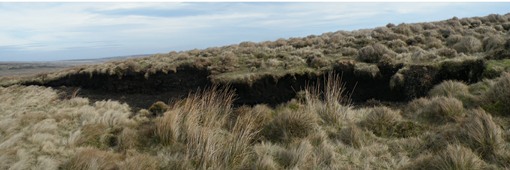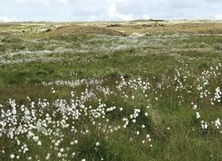

Biodiversity
Action
Plan

Blanket Bog. Bleak and wild, the cotton grass-dotted Blanket Bog landscape stretches out to the horizons of the South Pennine moors in the west of Barnsley. Formed on waterlogged ground where peat has accumulated in depth over thousands of years, Blanket Bog supports a special array of wildlife, including Golden Plover, Dunlin, Curlew, Common Lizard and Mountain Hare.
Blanket bog has formed in upland areas of heavy rainfall where the ground becomes waterlogged and plant remains have accumulated as deep peat. Most peat formation began 5000-6000 years ago, it is thought partly due to woodland clearance, and is largely made up of cotton grass and sphagnum moss remains.
The resulting very wet, acidic and nutrient-poor conditions mainly suit a limited range of plants: mosses, cotton grasses, rushes and grasses; peaty pools; and drier hummocks of Heather, Bilberry and Crowberry. However there are a number of unusual plants adapted to this specialised habitat, including sphagnum mosses, Bog Asphodel, Cranberry and the Round-leaved Sundew.
Blanket bog is of great importance for breeding Golden Plover and Dunlin; the South Pennines is the furthest south in England that they breed. Red Grouse, Curlew, and Snipe utilise blanket bog, as well as, more rarely, Merlin and Short-eared Owl. Common Lizard and Mountain Hare are also found on blanket bog, as well as the lower, linked heather moorland.
The quality of the blanket bog habitat has suffered significantly, with a decline in species diversity as a result of air pollution, over-grazing, inappropriate or accidental burning, peat extraction and past drainage. At their worst, these impacts have led to substantial areas of eroding moor, seen for example on Langsett Moors.
When in good condition blanket bog absorbs carbon dioxide from the air, laying down peat. Peat is in fact the biggest single store of carbon in the UK; the drying out and erosion of the peat risks releasing this carbon into the atmosphere. This makes it all the more important for its restoration and conservation.
For more information on Blanket Bog, follow these links:
Priority habitat details
Blanket Bog is a local priority habitat because of its national status, the species it supports and the potential for its restoration and conservation.
Blanket Bog is a UK BAP priority habitat and Section 41 habitat of principal importance.[UKHab f1a]
It is found mainly above the 400 metre contour on Barnsley’s upland moors where it covers 2164 ha.
Phase 1 habitat surveys list it as bog.
Blanket bog is strongly dominated by cotton grass and mosses.
It is distinguished from heath by its occurrence on deep peat (>0.5 m) and by having less than 25% heather-like dwarf shrubs.
The National Vegetation Classification (NVC) categories for blanket bog in Barnsley are:
M3 (Eriophorum angustifolium bog pool community),
M19 (Calluna vulgaris – Eriophorum vaginatum blanket mire),
M20 (Eriophorum vaginatum blanket mire)
M25 (Molinia caerulea – Potentilla erecta mire),
together with intermediates.
Other communities, such as flush, fen and swamp types,also form an integral part of the blanket bog landscape.


Blanket Bog